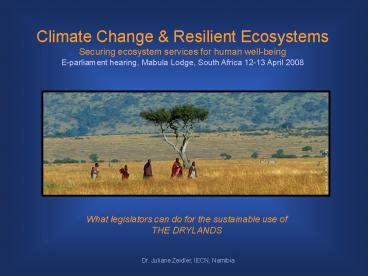Climate Change - PowerPoint PPT Presentation
1 / 18
Title: Climate Change
1
Climate Change Resilient Ecosystems Securing
ecosystem services for human well-being E-parliame
nt hearing, Mabula Lodge, South Africa 12-13
April 2008
What legislators can do for the sustainable use
of THE DRYLANDS
Dr. Juliane Zeidler, IECN, Namibia
2
What is special about drylands?
- Naturally arid climates, prevailing droughts are
normal - Water is scarce and often the limited factor for
sustainable development o f drylands - Traditionally, people mainly live on livestock
(pastoralists), game and some plants and fruits -
relatively low impact - Agriculture depends heavily on water - drylands
agriculture is seldom sustainable and requires
high inputs - Biodiversity is uniquely adapted to the climatic
and environmental conditions
3
Map of world drylands
4
Did you know .
- That drylands occupy approximately 50 of the
Earths land surface around the world? (excl. the
Arctic and certain Tundra areas) - That about 70 of the drylands worldwide are
affected land degradation and loss of
biodiversity? - That all drylands are faced with climate change
impacts and have to adapt to them accordingly? - That more than 35 of the worlds population is
living in drylands, many directly depending on
natural resources and biodiversity for their
daily survival food, water health? - That a majority of people living in drylands are
living poverty?
5
A majority of people living in drylands are
living in poverty peoples development and
ecosystem objectives need to be addressed
together!
6
CC Risks and Impacts to be expected
- Increase in temperature reduced rainfall
- Increased rainfall increased temperature
- Increased rainfall
- More extreme events (droughts floods)
- Changes in growing season ecosystem shifts
7
CCA action areas
(a) Water resources (b) Food security and
agriculture (c) Health (d) Disaster preparedness
and risk management (e) Infrastructure (f)
Natural resources management (g) Community level
adaptation
8
Some policy responses Case examples
9
Some case studies from Africa
- Namibia Wildlife as drylands compatible land use
- Eritrea Options for water usage and range
development
10
- Namibia Wildlife as drylands compatible land use
11
A Growing Land Management Option CBNRM Wildlife
- 50 Conservancies gazetted to date
- 118,276 km2 (13 of Namibias land mass) now
falls within communal area conservancies - 212,000 people living in conservancies
12
Results Game Populations
13
Results Economic Impacts
14
Source of Benefits - 2005
15
- 2. Eritrea Options for water usage and range
development
16
(No Transcript)
17
Some key policy option areas
18
Some key policy option areas
- Community Empowerment and strengthening of
adaptive capacities incl. Community-based Natural
Resources Management (CBNRM) - Appropriate and compatible land uses
- Safeguards SEA/EIAs feasibility assessments
red flags - Mainstreaming CC and drylands concerns into key
national development policies focus on
adaptation - Reducing carbon emissions SLM, sustainable
energies and energy efficiency, watershed
management and conservation































